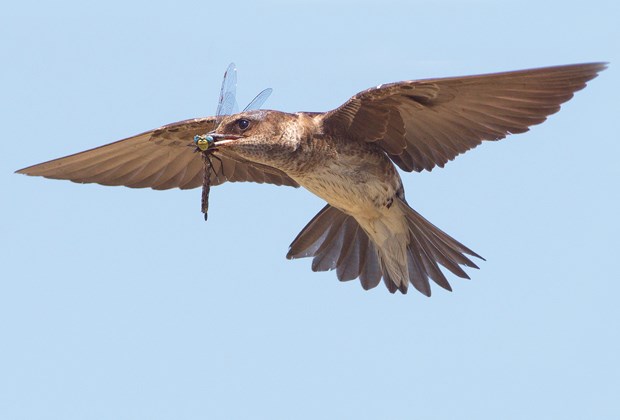"Summertime and the livin' is easy," goes the song, but not for the birds.
For them it's a busy time of raising their families and preparing for the challenges of autumn. Some, like warblers, vireos, flycatchers and swallows, will migrate to sub-tropical and tropical wintering grounds. For example, our purple martins spend the winter in Brazil. Swainson's thrush, blackheaded grosbeak and western tanager are other examples of local neotropical migrants. Summer is a bountiful time for birds with an abundance of fruit and insects in suitable habitats like the Conservation Area at Maplewood Flats. One of the choice bird-friendly shrubs is red elderberry with its grape-like clusters of bright red fruits. A bush with ripe elderberry fruit is a great place to watch for robins, waxwings, Swainson's thrushes, black-headed grosbeaks and other fruit-eating birds. And of course, birds help to disperse seeds of elderberry and other plants in their droppings, ensuring more berries and more habitats. The Swainson's thrush has been called the salmonberry bird because it is so closely associated with this raspberry-like shrub. Blackberries are a favourite of a long list of birds and mammals. Even dried (mummified) blackberries are consumed by a variety of seed predators, like the purple finch, house finch, song sparrow and spotted towhee, all of which means that berry thickets are great places to watch for birds any time of the year.
Seasonal changes happen slowly with one season developing into the other. For example, one can see the signs of fall by mid-or late-summer. Male Rufous hummingbirds will be largely gone locally by midsummer, making their way inland to the mountains to take advantage of abundant wildflowers, finally winding up in southern Mexico. It is indeed an incredible journey and said to be one of the longest for all hummingbirds - some breed in Alaska. Once the last Rufous has departed the North Shore in late summer, we are left with Anna's, so don't be surprised to see hummingbirds in midwinter.
By mid-summer, visitors to the conservation area can enjoy a wonderful diversity of wildlife. Bald eagles and ospreys are busy raising their young. Watch for these raptors perched on dolphins in Burrard Inlet. Osprey Point at the sanctuary is a fine viewing point. Here you can also enjoy watching and listening to the beautiful purple martin as it swoops through the air catching insects like dragonflies. By carefully checking posts offshore, you might be lucky to discover a peregrine falcon. And always look to the sky for soaring birds, like eagles, vultures, swifts and swallows.
You can sometimes notice lots of feathers cast up on the beach - especially of the Canada Goose. It is not a problem, it is simply mid-summer moulting time. Feathers wear out and need to be replaced from time to time - something all birds must deal with. Speaking of waterfowl, everyone at the sanctuary was thrilled to see a beautiful hooded merganser and wood ducks with their broods of chicks - very exciting indeed. Birds to be looked for in the sanctuary's woods include the Swainson's thrush, warbling vireo, black-headed grosbeak and red-eyed vireo. Once upon a time the red-eyed vireo was known as the preacher bird because it sings over and over, up to 20,000 times per day it is said.
In late June birders at the sanctuary were thrilled by excellent sightings of a Western kingbird, a species more associated with the dry interior. Sightings of rare species are the spice of birding and the conservation area keeps on producing such wonders. Over the years we've seen Tennessee warbler, mountain bluebird and long-billed curlew. But all birds are wonderful and all have something to teach us and to bring us joy.
Sunny days at the sanctuary are also great for butterfly and dragonfly photography. Watch for photographers and see their work; learn about purple martins and ospreys; take in a puppet show about the pacific herring; learn about knotweed and how to get rid of it; and go on nature walks. For full schedule, pick up an information sheet at the WBT office Saturdays and Sundays between 10 a.m. and 4 p.m.
Al Grass is a naturalist with Wild Bird Trust of B.C., which offers free walks at the Conservation Area at Maplewood Flats on the second Saturday of every month. Meet at WBT's site office, 2645 Dollarton Hwy., North Vancouver. Walks go rain or shine.
Colourful dragonflies like skimmers, darners, and beautiful butterflies like Swallowtails, tortoiseshells and admirals.
Enjoy a summer day at the conservation area with beautiful birds, butterflies, dragon flies and wildflowers awaiting your discovery. Keep safe.
The Wild Bird Trust is holding a Return of the Osprey event at the conservation area July 26 and 27, 10:30 a.m.-4:30 p.m. Activities will include a chance to learn about how to identify butterflies; meet local artists and photographers and see their work; learn about purple martins and ospreys; take in a puppet show about the pacific herring; learn about knotweed and how to get rid of it; and go on nature walks. For full schedule, pick up an information sheet at the WBT office Saturdays and Sundays between 10 a.m. and 4 p.m.
Al Grass is a naturalist with Wild Bird Trust of B.C., which offers free walks at the Conservation Area at Maplewood Flats on the second Saturday of every month. Meet at WBT's site office, 2645 Dollarton Hwy., North Vancouver. Walks go rain or shine.



